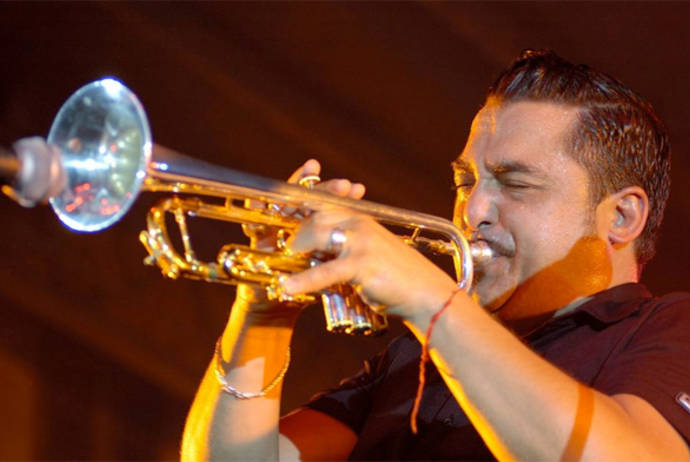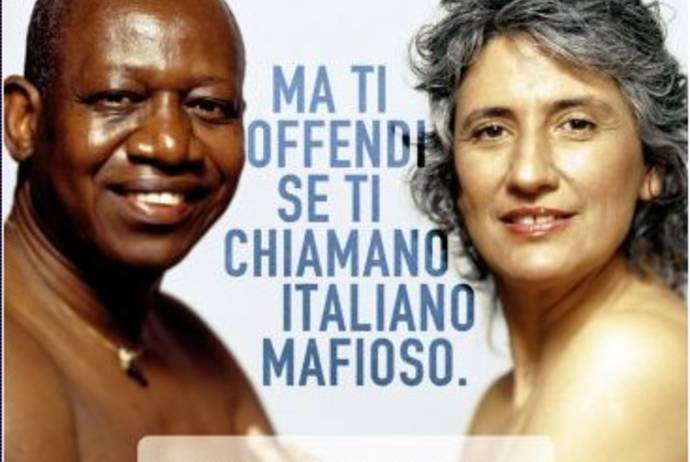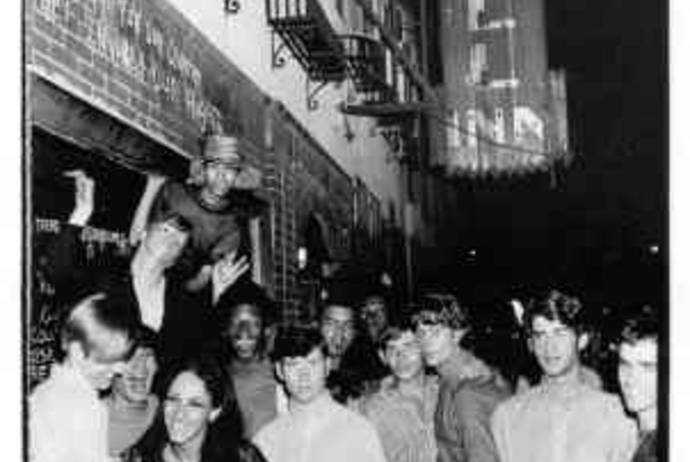Jazz has been popular in Italy since the 1920s, and the list of Italian American jazz musicians is lengthy, stretching from New Orleans trumpeter Nick La Rocca in the 1900s to saxophonist Joe Lovano, a leading figure in contemporary jazz. But Italian-descended jazz musicians rarely have used Italian musical forms as the basis for improvisation or original compositions. Lovano, on his acclaimed Viva Caruso album, is an exception. Another is the Sicilian-Canadian guitarist and composer Michael Occhipinti.
Occhipinti, a Toronto native well-known in Canada as the co-leader of the big band NOJO, is the founder and leader of The Sicilian Jazz Project, a band that re-interprets Sicilian folk and popular music. He, his brother Roberto, the band’s bassist, and vocalist Dominic Mancuso are the Sicilian core of the multiethnic ensemble. The SJP’s debut CD was released internationally last year, winning stellar reviews. The magazine All About Jazz called the album “exquisitely memorable.” The Sicilian Jazz Project is an outstanding work -- brilliantly conceived and performed, soulful, exciting, and surprising. I recently interviewed Michael about the origins of the SJP, his approach to traditional Sicilian music, and Sicilian (and Sicilian-Canadian) language and identity.
What inspired the creation of the Sicilian Jazz Project?
The Sicilian Jazz Project was inspired by a couple of things. In 2000 I made a CD called Creation Dream -- The Songs of Bruce Cockburn where I reinvented [Canadian singer-songwriter] Bruce Cockburn's songs as jazz pieces. I really enjoyed that process and wanted to do a similar project, but I wasn't sure what to tackle. Then, in early 2004, when my daughter Beatrice was three months old, I had a gig in the Netherlands and my wife and I decided that we would take the opportunity to visit Sicily to see my cousins there. I think having a child, coupled with the fact that my parents passed away in the mid-90s and being around my aunts and cousins, made me want to explore my Sicilian background a little deeper. My parents loved music and certainly I'd heard popular Italian music at weddings when I was a kid, but by the time I was playing music in my teens I predictably wanted nothing to do with it. I realized, however, that over the years I’ve performed music from all over the world and yet had avoided the place my parents were from, so the idea started to germinate. I mentioned it to my cousins and they gave me a few folkloric recordings to listen to. When I returned to Canada my brother Roberto let me hear the field recordings that musicologist Alan Lomax [and his Italian associate Diego Carpitella] had made in Sicily in 1954 and I think that was the final piece that made me decide to put the project together.
How did you decide to approach the Sicilian material, very well known songs like “Viti ‘na crozza” and “Ciuri Ciuri?” Did you have a particular concept in mind guiding your interpretations?
“Vitti na crozza” and “Ciuri Ciuri” are definitely the two well-known pieces on the recording, but most of the music was obscure and particular to certain towns and types of work, such as “The Sulphur Miner.” With the more obscure music, it was a process of figuring out whether a piece lent itself to reinterpretation, and of course that involved examining the musical elements of each one. With the popular Sicilian songs, it was more about the challenge of taking music that a lot of people have recorded over the years and seeing what could be done to the songs to make them different and surprising, as well as fun for the musicians to improvise over. With “Vitti ‘na crozza,” I simply decided to take the major key chorus and put it into minor, and that gave it more of blues feel, and then I messed around with some African drum patterns and decided to make it into a kind of African blues. “Ciuri Ciuri” was a response to my sister Silvia because she thought I was kidding when I told her I was going to record all Sicilian music. She said, “Yeah right, what are you going to do, ‘Ciuri Ciuri’?”
With regards to having a concept, in many cases it was about changing the Sicilian elements in the songs to make them better suited to a jazz treatment or just different. For example, so much of the music is in a triplet feel. Think of the tarantella which has a kind of LONG--short LONG--short LONG--short LONG--short rhythm. One of my first concepts was to get rid of that very basic Sicilian musical element and change it to something else. Hence we turn ‘Jolla’ into a 7/4 funk groove.
As a jazz musician, what appeals to you about this material, Sicilian musica popolare?
I have pretty eclectic tastes and to me jazz is a very broad category of music, so the appeal was in the variety of music I heard on Alan Lomax's field recordings. Between the Sicilian dialect and the strong Arabic influence in some of the music, some pieces didn't sound Italian at all to many people I played the recordings for -- they thought it was African -- so I knew we could cross a lot genres, which I like to do. I also thought we could open up people’s ears to sounds that they don’t always identify with Sicily.
Of the selections on the album do you have any particular favorites?
I like different pieces for different reasons, but “The Almond Sorters” and “The Sulphur Miner” are a couple of favorites. “The Almond Sorters” largely came about because a great classical music group, The Gryphon Trio, asked me to contribute something to a concert they were doing involving a number of guests, including Maryem Tollar, who sings it [on the album]. She's actually Egyptian, but she sings Sicilian dialect really well. “The Sulphur Miner” is based on an absolutely haunting performance by a sulphur miner, and every time I hear our singer Dominic Mancuso sing it, I still get chills. It is emotionally very powerful and really casts a spell on audiences and it pretty much always gets the strongest response when the final notes dies out.
Unlike many Italian Americans, whose forbears left Italy 100 years ago and who no longer have any real ties to la madrepatria, you have family in Sicily. How has that connection influenced the SJP?
Most of the Italians in Toronto came in the 1950s and have retained, at least for one or two generations, some of their dialect, and like me, have stayed connected to the family that remained in Sicily. In my family’s case, we're really close with our first cousins in Modica. For me, it’s an important connection because my own parents have passed on, so the opportunity to be around their siblings and to speak the dialect I learned as a kid makes me feel like I get to tap into a part of myself that I don't get to at home in Toronto. When my parents immigrated in 1952/53, their dialect froze with them, while the language continued to evolve in Sicily. It’s really easy for me to switch from Italian to what is now called “archaic dialect,” and it still puzzles a lot of people there how well Roberto and I know the old way of speaking and how well Dominic Mancuso sings it. Maybe more than anything, a first hand knowledge of dialect and affection for it probably was the strongest attraction to the repertoire of the SJP.
The SJP has three members of Sicilian background, you, your brother Roberto, and vocalist Dominic Mancuso. For you three, this music is part of your cultural patrimony. But how did the others in the band adapt to it?
The other musicians in the group come from really varied backgrounds, not only with regard to their own heritages, which are Portuguese, Hungarian, French/Native Canadian, Egyptian. They also perform many kinds of music -- Cuban, classical, fado, South Indian, funk, etc -- so it’s a pretty adaptable band. I think that in a multicultural city like Toronto, most modern musicians take it for granted that they'll do gigs and musical projects that jump between cultures. I didn’t feel the need to do too much cultural translation because I didn't start the SJP with the idea of performing authentic Sicilian folk music. Instead, I wanted to re-imagine Sicilian music so that it reflected the place that I grew up in, and for me that meant taking advantage of all of the knowledge the different musicians bring to the project. Having said that, there are some moments in the music when we do try to sound “authentic,” and the musicians are so good and adaptable that when I let them hear the source recordings, they know exactly what they need to do or take instruction really quickly.
Since the recording was issued, where has the SJP performed?
The album has had a great reception worldwide and we've been able to tour quite a bit. When we went to Sicily for the Ragusani prize, Roberto, Dominic and I got to perform an outdoor show in my parents’ city of Modica, as well as in the opera house where our dad used to enter amateur singing contests, so that was probably the most emotional gig. With the full band we did an amazing festival in Zacatecas, Mexico where, even though we were completely unknown, the outdoor concert ended with a mini-parade breaking out and everyone clapping and singing along. Other highlights for me have been the Rochester [New York] and Montreal jazz festivals. I think we're going back to Italy this year and hopefully to Australia next year.
What kinds of reactions do you get from your audiences – do the Sicilians/Italians experience it differently from non-Italians?
The vast majority of gigs we've done have been for non-Italians, and it’s very gratifying that at performances like the Zacatecas festival or at the Vancouver Jazz Festival or the Ottawa Chamber Music Festival, the audience is always captivated by the music and the stories that go along with the songs, and they relate to it. I describe it as being akin to Cuban or African music, in that people can enjoy the music and absorb the emotion behind it without understanding the words, although I do make a point of telling the story behind most of the songs we play. When we do gigs aimed at the Italian community, or perform in a place like Rochester where there are a lot of Italian-Americans, we get a lot more people connecting to it nostalgically as well as musically. At those shows people come up and start telling their own personal stories and what the music meant to them, and that's really moving.
Do you listen to contemporary Sicilian music, whether pop stars like Roy Paci and Carmen Consoli, or more folkloric bands like I Lautari?
When I was gathering material for the recording I checked out a lot of music, both looking for authentic renditions and also looking at how current Sicilian musicians were interpreting folk music, as I was determined to try to be a little different. Yes, I’ve heard Roy Paci, and I actually got a few ideas from listening to a singer named Carlo Muratori, who has a pretty vast knowledge of Sicilian song. Even though he’s not Sicilian, I'd listened to Renzo Arbore quite a bit too, as I like what he does with really familiar songs.
What do you think of Sicily’s image in the world, and are you consciously trying to say something about that with the SJP?
The first time I went to Sicily as an adult was in 1992 and I went over with my own naive assumptions about the place. I figured I’d see my family and then travel north to see all the “cool” Italian stuff that the tour books tell you to go see. I had no idea how beautiful Sicily was, and I was really blown away. At that time, however, the news was dominated by Mafia assassinations [Note: anti-Mafia magistrates Giovanni Falcone and Paolo Borsellino were assassinated in 1992] and even in a peaceful place like Modica there were soldiers guarding some of the buildings, so it was hard not to be aware of Sicily's reputation. In fact, on that trip I realized how many northern Italians had never visited Sicily and when I told them I’d been there they'd say "é brutto, no?" and I’d have to say “no” and tell them that in fact it was one of the most beautiful places we'd visited and that the people were fantastic. I don't know if I've set out to say something about Sicily's image with my project, but I do enjoy telling audiences about its history and the lives of the people they encounter in the songs. I also like to remind audiences that North America isn’t the first multicultural place that’s existed. Arabs, Jews, Christians, Normans, and Spaniards all left their mark in Sicily, and for a few centuries all of those cultures lived alongside each other pretty well.
You and Roberto were awarded the Ragusani nel Mondo Award in Ragusa, Sicily last year. What is the award, and how did it happen that you and your brother were selected to receive it?
The Ragusani nel Mondo recognizes achievement in different fields by people who trace their roots to the province of Ragusa. The Sicilian Jazz Project was part of why Roberto and I were selected since it’s my creation and he produced it and plays on it, but the award also recognized that we’ve both had busy careers as individual musicians prior to working on the SJP together. It was a fabulous experience. We took our singer Dominic Mancuso with us, and performed a couple of open air shows plus the award show itself, which was televised worldwide.
Will the SJP tour this year, and any plans to play US cities?
I definitely want to tour the band as much as possible as the musicians are not only great players; they are my friends and are really devoted to the project. I’ve been working on some European dates, and I also will be spending three or four months in Sicily later this year researching more folk music and learning more of my own history in Sicily. But I do want to build on the great response we received in Rochester by getting back to the U.S. more often. I'm waiting to hear on some dates in New York City, New England, and California, and if any of your readers want to book us, go for it!
































 Paci and his band Aretuska came to the borough – actually, Avenue P, in Bensonhurst -- as part of a weeklong series of events in New York and New Jersey organized by Italy's National Association of Migrant Families (ANFE) for Italian Heritage and Culture Month.
Paci and his band Aretuska came to the borough – actually, Avenue P, in Bensonhurst -- as part of a weeklong series of events in New York and New Jersey organized by Italy's National Association of Migrant Families (ANFE) for Italian Heritage and Culture Month.





